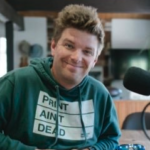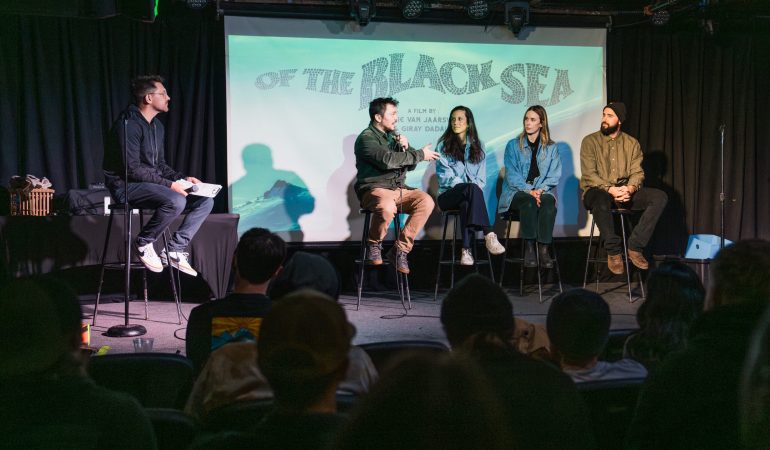Today, merely finding meaningful work as a consumer of media is a challenge. As for bringing good work to life, well as easy as technology’s tools have made the creative process, the distribution end is in turmoil. But change brings opportunity. Hence Journal contributor Dan Oko’s reporting offers a snapshot of where storytelling is going. Photo illustration by Dave Cox. (No generative AI was employed in the above image satirizing generative AI.)
Longer Reads: Feeling Like You’re About to Get Run Over—Again?
Dan Oko Explores the strange new media World of Woolly Mammoths and Media Zombies
Back in April, Mike Rogge, the publisher of Mountain Gazette, announced on LinkedIn that he was selling off a chunk of his magazine to an investor named Jeff Gates.
To those who know who Rogge is—he resurrected the “good ol’” Mountain Gazette in 2020, bringing back the celebrated out-of-print title after eight years—this seemed like the worst of news.
Holding a Tony Soprano cigar, the bearded Gates appeared on video, yapping about how he wanted to “elevate” the gazette, making all articles free online, and figuring out how to put “all the print” on YouTube, where celebrity influencers could weigh in on the latest issue. Given that Rogge, despite being just 34 when he bought the title, had extolled print-first, photo-rich long-form narratives on a paper periodical with a trim size that dwarfed even the large formats journal style magazines on the market, this news shocked and dismayed Mountain Gazette subscribers, who pay $70 for an annual subscription for two thick issues packed with content.
Then, as it sank in that Rogge had staged an April Fool’s joke, his followers had a good laugh.
Given the stakes these days for most outdoor storytelling professionals across print, online publishing, and filmmaking, 2024 has been otherwise lacking in notable chuckles. As media and tech become more and more intertwined, layoffs have continued to plague traditional and even “traditional digital” publishers, such as Vox and Buzzfeed. In the face of “economic headwinds,” Outside Inc. laid off about 18 percent of its employees in 2022, mostly journalists and other original “content producers,” eliminating a few titles while trimming the frequency of others—in addition to its namesake, Outside, the company owns Backpacker, Yoga Journal, and more (plus a host of apps and widely used race registration software). Meanwhile, a late 2023 reorganization at Conde Nast, home to venerable titles such as Wired, GQ, Condé Nast Traveler and the music site Pitchfork eliminated 300 jobs, or five percent of its workforce.
With so many outdoor creatives stranded on the steeps, Rogge’s prank underscored that rounds of investment—the likes of which were behind many of the recent deep cuts to print, film, and digital—are no panacea when it comes to making it as a storyteller. And when it comes to getting content out—from investigative journalism to personal narratives to documentary film and doc-adjacent outdoor adventure videos—nobody can really predict how that content will reach audiences in the next few years. It’s an old story to anyone with a print background, but only the extremely bold or the extremely foolish are willing to wager on predictions about how and where all manner of storytelling will travel from creation to audience over the next few years.
The extinction level event has already happened for magazines. We are the woolly mammoth that survived.
Indeed, Rogge has not only survived, his operation is thriving. Since its relaunch, Mountain Gazette has gained tens of thousands of subscribers, and he says the magazine continues to add another thousand every 7 to 10 days. That puts Rogge at the vanguard of a new generation of print publications. Some dabble with original content online, but at their core, they sell coffee-table-sized keepsakes. “We have been profitable since month three, and we are going into year four,” he says.
Other freshly-minted print titles include Summit Journal, a biannual climbing mag that ceased printing in 1996 and was brought back this year by Michael Levy, a friend of Rogge’s, and Ori, a travel magazine founded last year. The latter has committed to direct revenues back to freelancers with the Ori Creative Grant for longform articles.
While this analog uprising may not spell salvation for a large segment of struggling journalists and editorial photographers, it does offer storytellers an alternative to the scattered and skin deep, search engine optimized “content” promulgated by tech-minded investors.



No fall has been more precipitous, perhaps, than Sports Illustrated under the ownership of the Authentic Brands Group, the group behind Quicksilver, Reebok, and more. ABG leased the magazine’s publishing rights to the Arena Group after taking over in 2019; in turn, Arena fired its CEO when it was revealed that bylined articles had been generated by artificial intelligence alongside fake bios and headshots of AI generated contributors. That was a staggering misstep for the once-respected 70-year-old outlet. Then, this month, ABG sued Arena, which also owns Men’s Journal, Surfer, Bike, Snowboarder, and Powder, over millions of dollars in missing payments and other damages. Similarly, this past February, the news broke that the rabble-rousing vanguard digital publisher Vice was gutting its staff and ceasing editorial activity. Today, while the Vice website is limping along under its own licensing deal, Vice no longer produces its own original reporting. When publications used to go belly up, they vanished—now the algorithm feeds media zombies regurgitating old evergreen copy, augmented from time to time by press releases and updates rewritten and regurgitated by chatbots.
The shakeup makes it difficult to remember that before online media evolved into a wasteland of clickbait, influencers, and data harvesting, the blogosphere was ripe with dreams of new revenue streams. For a hot minute, savvy authors and charismatic filmmakers able to draw internet buzz realized profits through sponsorships and subscriptions, as well as targeted advertising. Gatekeepers be damned, with a GoPro and YouTube, anybody could post sharply edited videos while independent writers and photographers used personal channels to forge new pathways for distribution. A few, including Steve Rinella’s Meateater, became empires, but many outdoor communicators struggled. The arrival of deep-pocketed venture capitalists and institutional investors looking to score, forced creatives to pivot again. In such a crowded marketplace, trading free content in the hopes of going viral turned out to be bad business.
Today, lean sponsorship deals and advertising shrinkage across all platforms has left scads of veteran journalists and writers navigating this strange new world with neither compass nor GPS. Filmmakers suffer increasing post-pandemic fallout as funding and distribution channels for documentary and long-form video shrinks. The trend crosses all tiers: Budget cuts in Hollywood leave scant resources not only for production, but also distribution, marketing, and audience building. Following Sundance, trade journal Variety reported that streaming services are buying fewer documentaries. In the outdoor space, with the exception of brand-sponsored projects, notably from Yeti and Patagonia and others, long-form visual storytelling faces its own battle for survival in a consumer landscape where social-media platforms like TikTok and Instagram continue to erode the attention span of anybody with a mobile phone.
“We’re pretty much at the apex of everyone realizing that nothing is working in this industry, and that we need new ideas,” Brian Newman, independent producer and former CEO of the Tribeca Film Institute, observed in his Sub-Genre newsletter. Among other projects, Newman specializes in advising studios and filmmakers on brand building and audience identification.
David Holbrooke is a filmmaker and founder of Original Thinkers, a multimedia company focussed on social and environmental solutions, which hosts an annual summit each year in Telluride, Colorado. Before launching OT in 2018, Holbrooke—the son of Ambassador Richard Holbrooke, about whom he made a documentary The Diplomat, available on Max (formerly HBO)—was director of the Telluride Mountainfilm Festival.
How do you make a small fortune? Start with a large fortune, and get into the filmmaking business.
But it’s not just about the money, says Holbrooke, it’s about the quality films that nobody gets to see. “I know very few documentary filmmakers who do it to make money. They do it to tell stories,“ he continues. “But there are a huge number of films that have a very limited release. Finding the audience is a real problem.”
Holbrooke suggests filmmakers would do well to bring “deep humanism” to documentaries, work with philanthropic backers who don’t demand an immediate return on investments, and trust the long tail of the internet’s reach to eventually help good works get seen by word of mouth. (Full context though, Holbrooke is deeply suspicious of YouTube’s algorithms and sponsored-video model, which leaves so many independents out of the equations.)
“What I think is the bandaid on the wound is the people who are entrepreneurial enough to find their own audience,” says Holbrooke. He points to Substack as one platform that holds promise for writers—The Free Press, an alternative to the news juggernaut that is The New York Times now has more than 600,000 subscribers; Defector is a new independent voice covering professional sports with 57,000 paid subscribers—but there’s a lot of competition. On the filmside, Holbrooke has high hopes for the streaming site Documentary+, a curated collection of hundreds of films, ranging from Academy Award winners to episodic rarities. Mixed in with its biographies of pop stars (Bieber, Beyonce—celebrity sells) are a number of outdoor titles.
Having worked in outdoor media her entire professional life, filmmaker and photographer Julie Ellison has been in the trenches since she left the helm of Climbing magazine, where she served as editor-in-chief until late 2017 (since purchased by Outside Inc. Climbing ended its 52-year print run in 2022).
In 2016, Ellison and three friends formed a female-led production company, the Never Not Collective, and set about filming “Pretty Strong,” a movie about six women climbers including Scarpa athlete Isabelle Faus and the elite Mexican climber Fernanda Rodriguez. As co-director, Ellison set up a kickstarter, raising nearly $80,000, and that paved the way for support from sponsors such as REI, Black Diamond, and Mountain Hardware. The film premiered at the Boulder Theater in 2020. Ellison followed that release with “Girls Gone Hueco,” in 2023, which was screened in gear shops, climbing gyms, and a cidery in Ontario.
“Everyone is trying to figure out this new landscape,” says Ellison, who is concentrating on a few personal projects she finds meaningful while developing a strategy to transition to working with commercial clients. “The brands don’t really know about distribution and neither did we.” With a strong network from her magazine days, including luminaries such as Alex Honnold along with others, she credits the success of her films to the broader climbing community stepping up and saying “it’s time to pay attention to women athletes and creatives.”
Since 2007, Fitz Cahall the creator of the celebrated podcast Dirtbag Diaries—with 20 million downloads and counting—has been a trailblazing storyteller. Having worked as a print journalist, Cahall saw early potential online. He launched a web-based series on the outdoors, and went on to co-found Duct Tape Then Beer, a creative agency, adding film and brand consulting to his résumé. Centered on conservation challenges and experiences that encourage connections to the natural world, DTTB collaborators include Patagonia, Protect Our Winters, The North Face, and Google, and its films have won an armful of awards.
Despite industry turmoil, which is by no means limited to outdoor media, Cahall says he remains optimistic that longform storytellers will find their audiences—and get paid in the process. It may be too soon to say how that content will be delivered, but redefining success as a few thousand subscribers, say, instead of millions of followers, can put at least a few creatives on a sustainable path. That scale may not be what shareholders look for first, he says, but content producers would do well to learn how scarcity helps create its own value.
“I’m the least confident I’ve ever been about what comes next.” Cahall continues—he’s been through the dot-com boom and the Great Recession, and drawing on those experiences plans to pull back until the dust settles. Too much content and shifting consumer habits underscore that rather than chase metrics per Meta and TikTok influencers, a more impactful strategy for writers and filmmakers is broadcasting top tier content to a limited but fully engaged audience.
In many ways, Cahall’s career offers a nearly perfect analogy to understand what creatives have been experiencing. He came into publishing on the eve of the century’s first great media meltdown, 2001, as his friends and colleagues riding the start-up bandwagon fell to earth. He found his path online as the internet became more democratized—his early web series garnered more than three million views in 2009, when that was a novel way to distribute content—and then found a profitable way to work with brands on strategies that establish their authenticity. “Lately, we’ve been trying to develop film projects that we can work on for a few years,” he says, noting that Dirtbag Diaries has also trimmed its podcast production schedule.
Cahall doesn’t give away specific project details, but he makes it clear that his crew’s success will be defined by producing a meaningful film rather than winning the infotainment lottery. “And maybe it gets a release to a streaming platform, or it goes to YouTube, and the brand will pay so it gets seen once it’s made,” says Cahall, noting that online media is as tumultuous as it had been since he got his start.
In changing times, Cahall draws upon lessons learned from a lifetime of adventure—and the need to stay agile in the face of challenges.
The optimist side of me recognizes this insecurity from my own experience being in the outdoors. But the riskiest situations can also be, potentially, the most deeply rewarding.
A lot of professionals are fighting through uncertainty to forge new opportunities, cobbling together grants, Kickstarter campaigns, and sponsorships to tell impactful stories. Non-profits have come onboard, bringing to light hyper-local stories and improving the media mosaic. Meanwhile, consumers subsisting on charticles, reels and text-heavy IG posts remain hungry for meaty narratives that contextualize the human condition. Podcasting has exploded since 2017. Medium is yet another landing pad for writers, and programs like Patreon, which serves many platforms, can earn producers $50,000 monthly with as few as 20,000 subscribers. Hope springs eternal, and journalists willing to work without a net continue to hustle in the name of speaking truth to power, recovering lost history, or simply to spin a captivating tale. Artificial intelligence may yet add to the static, but craft and authenticity still draw eyeballs too.
That’s been the winning formula for Mountain Gazette, where Mike Rogge is ready to ship his latest issue. With his subscriber base growing markedly, and a “99.02 percent” renewal rate, Rogge has found a readership willing to pay for quality content beyond the scroll-happy masses. This year, Mountain Gazette will add staff and commission more in-depth stories about the outdoors. And despite his April Fools stunt, Rogge won’t be taking on investors anytime soon. “I’ve been a freelancer. I’ve been an editor. I thought I could do it better,” he says.
“I think niche media is doing great,” says Rogge, pointing to other reader-supported brands such as Surfer’s Journal, Adventure Journal, Alpinist, and Golfer’s Journal (“all the journals,” he quips). Advertisers have come on board, naturally, but the main focus is their readership. “We own our audience, and we don’t care about the number of followers on Facebook or Instagram.”








